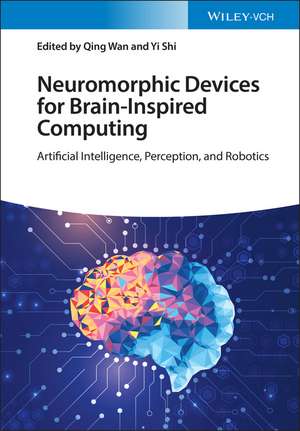Neuromorphic Devices for Brain–inspired Computing – Artificial Intelligence, Perception and Robotics
Autor Q Wanen Limba Engleză Hardback – 25 ian 2022
Preț: 847.37 lei
Preț vechi: 985.32 lei
-14% Nou
Puncte Express: 1271
Preț estimativ în valută:
162.14€ • 169.75$ • 134.16£
162.14€ • 169.75$ • 134.16£
Carte disponibilă
Livrare economică 15-29 martie
Livrare express 04-08 martie pentru 37.63 lei
Preluare comenzi: 021 569.72.76
Specificații
ISBN-13: 9783527349791
ISBN-10: 3527349790
Pagini: 256
Dimensiuni: 171 x 267 x 18 mm
Greutate: 0.61 kg
Editura: Wiley Vch
Locul publicării:Weinheim, Germany
ISBN-10: 3527349790
Pagini: 256
Dimensiuni: 171 x 267 x 18 mm
Greutate: 0.61 kg
Editura: Wiley Vch
Locul publicării:Weinheim, Germany
Notă biografică
Qing Wan is currently a professor in the School of Electronic Science and Engineering, Nanjing University, China. He received PhD degree from Shanghai Institute of micro-system and Information Technology, Chinese Academy of Sciences in 2004. From 2004 to 2005, he worked as a postdoctoral researcher at the Department of Materials, University of Cambridge. From 2006 to 2007, he also worked as a postdoctoral researcher at the Department of Electronic Engineering, University of Michigan, Ann Arbor. His research focused on the semiconductor micro/nano structures for new-concept device applications. Qing Wan has published more than 200 scientific papers and SCI cited more than 10000 times. Qing Wan has won many awards, including National Youth Top-notch Talent, China Youth Science and Technology Award, Natural Science prize of the Ministry of Education (first-class prize), Author of National Excellent Doctoral Dissertation of PR China, Special award of the President of the Chinese Academy of Sciences, NSF distinguished Young Scholars. Yi Shi is a full professor of the school of Electronic Engineering, Nanjing University. He obtained Ph. D in Department of physics, Nanjing University in 1989. He has been visiting professor to Cambridge University, Tohoku University, and University of California (Berkeley). He has published over 300 articles on peer reviewed journals including Nature Commun., Nano Lett., Adv. Mater., and Appl. Phys. Lett. He was promoted to Changjiang Chair Professor in 2007, and is the principle scientist of several scientific research plans, such as the national basic research program of China. His research interests mainly focused on Nanoelectronics and Nanophotoelectronics.
Cuprins
TWO-TERMINAL NEUROMORPHIC MEMRISTORS Memristive Devices Resistive switching mechanisms Memristive Bioinspired Devices Memristive Neural Networks Summary and Outlook SPINTRONIC NEUROMORPHIC DEVICES Spintronic Synapses Spintronic Neurons Implementation of Spintronic Neuromorphic Computing Systems Summary and Outlook MULTI-TERMINAL NEUROMORPHIC DEVICES WITH COGNITIVE BEHAVIORS Introduction Multi-Terminal Neuromorphic Memristors Multi-Terminal Neuromorphic Transistors Neuromorphic Transistors for Perception Learning Activities Conclusion and Outlook NEUROMORPHIC DEVICES BASED ON CHALCOGENIDE MATERIALS Chalcogenide Materials Nonvolatile Phase Change Memory Switching Mechanisms Volatile Threshold Switching Mechanisms Implementation of Artificial Synapses based on MS Effects Implementation of Artificial Neurons based on TS Effects Hardware Neural Networks Summary and Outlook NEUROMORPHIC DEVICES BASED ON ORGANIC MATERIALS Two-Terminal Organic Neuromorphic Devices Three-Terminal Organic Neuromorphic Devices Innovative Applications of Organic Neuromorphic Devices for Artificial Sensory Systems Summary and Outlook NEUROMORPHIC COMPUTING SYSTEMS WITH EMERGING DEVICES Introduction Neuromorphic Devices DNN based on Synaptic Devices SNN based on Neuromorphic Devices Other Systems based on Neuromorphic Devices Summary and Outlook NEUROMORPHIC PERCEPTUAL SYSTEMS WITH EMERGING DEVICES Background Sensation and Perception Implementation of Artificial Perception Summary and Outlook
